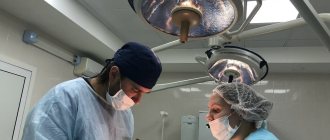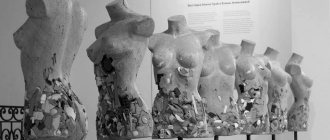Lifting
– face lift.
Types of face lifts:
- Endoscopic frontotemporal lifting
- Endoscopic midface lift
- Combined endoscopic lifting of the frontotemporal and middle areas of the face
- Facelift
- Eyelid lift (blepharoplasty)
During a facelift, the plastic surgeon first separates (mobilizes) part of the skin from the underlying tissues. The area that has gained mobility is moved and fixed in the lifting position (in the position necessary for a facelift), thus a full and effective facelift is carried out.
Photos "Before" and "After"
See more “Before” and “After” photos
Surgical facelift
A circumferential facelift (rhytidectomy) is an aesthetic surgical procedure aimed at recreating a youthful appearance. After the procedure, the sagging of skin folds in the cheek area, near the ears, along the lower jaw line in the area of the so-called jowls is reduced. When performing a circular correction of the oval of the face, the skin is detached and surgically applied to the deeper layers in order to return them to their previous position, restore a more youthful contour and remove excess skin. Together with face lifting, platysmoplasty (neck lift), blepharoplasty (eyelid surgery) and lipofilling (creating volume on the cheekbones using the patient’s own fat) are performed.
Photo after surgical SMAS lifting
Plastic surgery at 45 years old is a way to achieve skin rejuvenation
With age, a woman’s skin changes, and skin aging is observed. They lose their elasticity, begin to sag, and deep wrinkles appear, which leads to loss of the shape of the facial contour. The amount of subcutaneous fat, which forms the relief of the face, decreases, so it ceases to look toned, young, and elastic. Plastic surgery after 45 years is a method of skin rejuvenation for a modern woman, a way to restore freshness, elasticity, eliminate flaking and dryness, remove forehead wrinkles, and age-related changes. In this way it is impossible to stop the aging process, but it is possible to slow it down by 10 years.
The condition of the skin at 40-45 years old varies significantly among different women, it all depends on individual characteristics and heredity.
With the help of cosmetic procedures, plastic surgery, contour plastic surgery, and injection methods, it is possible to rejuvenate the skin and eliminate many aesthetic problems: from classic lip augmentation and restoration of the shape of the lips to correcting the shape of the nose for medical reasons. A facelift involves redistributing the skin and removing excess skin. This makes it possible to correct the influence of gravity, create a new contour, and get rid of wrinkles.
Is it necessary to have a facelift after 45 years: possible contraindications
Cosmetologists recommend surgical and non-surgical interventions to eliminate deep nasolabial folds, lift the lower part of the face, excess fatty tissue in the chin area, lack of skin tone with a significant number of wrinkles, and eyelid lifting. You can also correct the result of a person’s sudden weight loss, ptosis in the cheek area. If previously silicone compounds were used, which did not dissolve and remained in the tissues, today safer materials are used to rejuvenate the skin: for example, fillers with hyaluronic acid of non-animal origin. The substance is hypoallergenic and is eliminated from the body after a year. This material promotes the synthesis of its own acid, which creates an impressive rejuvenating effect and does not affect the condition of the body.
Any method of facelift after 45 years is low-traumatic and is tolerated quite well, but there are also contraindications:
- diseases of the nervous system, epilepsy;
- malignant neoplasms, diseases of internal organs;
- blood clotting disorder.
Relative contraindications include pregnancy, menstruation, lactation, infectious diseases, and skin problems.
What problems does surgery NOT solve?
Facelift is without a doubt a very effective procedure. But in some aesthetic problems it is powerless.
- Skin hydration. To deeply moisturize the skin, I recommend injection procedures - biorevitalization and mesotherapy.
- Skin tone and elasticity. I notice good results after a course of laser resurfacing in combination with injection techniques.
- Small superficial wrinkles. The introduction of soft fillers is eliminated.
- Pigmentation. Laser procedures or chemical peelings are also indicated.
⇒ INFORMATION: Causes of wrinkles and ways to eliminate them
Who is a good candidate for plastic surgery?
From the above it follows that the doctor must be extremely attentive and careful about the patient’s expectations. If a patient after plastic surgery expects an instant and complete transformation from a mature to a young person, it is worth either explaining the real effect again or refusing to intervene.
Inflated expectations are a factor that negatively affects doctor-patient communication and the perception of the final result.
In general, plastic facelift has indications for a wide range of patients. The first to apply are patients aged just over 40 years - these are those who want to prevent impending age-related changes. The next age category is about 48-50 years old, those who want to eliminate existing and progressive age-related changes. And then patients aged 55+ with significant external manifestations of aging, its heavy lower third, sagging, flabby neck.
The ideal age for this procedure is 45-55 years. I don't recommend expecting maximum tissue deterioration. An operation performed during this interval will give a more pronounced and long-term effect.
⇒
Essentially about the facial rejuvenation procedure after 35-50 years without surgery
Cosmetic facial rejuvenation is a worthy alternative to skin tightening through surgery. In addition, the cost of Thermage is generally lower and the effect is better.
The result of Facial Thermage is achieved by using weak current discharges affecting the middle and deep skin and fat layer. Electrical impulses stimulate collagen fibers, prompting the production of fibrillar protein. This element serves to give fabrics strength and elasticity. Therefore, this method of facial rejuvenation restores elasticity to the skin and tightens its oval.
The exclusivity of non-surgical facial rejuvenation is made by the fact that after the therapy, no traces of electromagnetic waves remain on the skin, since they act significantly below the upper layer of the dermis.
Considering the fact that procedures for facial rejuvenation using the ThermaCoolNXT device are quite expensive, such anti-aging therapy is more preferable due to the absence of surgical intervention in the human body. In addition, the treatment is absolutely painless, there is no recovery period, and there are no visible marks from the action of electrical impulses. The session duration ranges from 20 minutes to 2 hours.
Experts recommend using hardware facial rejuvenation no earlier than 35, but even then the procedure is possible at 40 and after 50 years. During these age periods, Thermage shows the most effective effectiveness, allowing you to forget about a visit to the plastic surgery clinic. In some cases, the procedure can be offered to people over 25 years of age as a preventive measure for severe signs of skin aging.
How is a facelift performed technically?
The surgery is performed under general anesthesia. The duration of a facelift is usually about three to four hours, but can be longer if it also includes the simultaneous implementation of additional aesthetic measures. The procedure involves detaching the skin of the face and neck with tightening of deeper tissues and muscles. Excess fat tissue is removed by liposuction or by redistribution and relocation. The skin is then placed along the new contours of the face, its excess is removed and sutured with cosmetic stitches. The incisions used for a circumferential facelift depend on the goals.
SMAS - face and neck lift, upper eyelid surgery, chin liposuction
3 main techniques
- SMAS lifting - the incision begins in the temple area in the hair or in front of the hairline, then goes down in front of the ear, continues behind it and again hides in the hair. Sometimes an incision under the chin is necessary to correct the anterior neck and create a more defined cervicomental angle.
- Mini-lift or MACS lift - a shorter incision, starting at the hairline directly above the ear, then similarly passes in front of the ear, but does not continue beyond it. This procedure is effective for early signs of aging in the lower face, especially mild to moderate sagging in the jawline area. Younger patients often go for a mini-facelift when visible signs of aging appear that make you look tired, overworked, or older than you actually are. This procedure is not intended to correct severe sagging of the jowls or neckline, rather it should be used to create a smoother, more lifted contour.
- Neck lift - the incision starts in front and just above the earlobe, and then continues along its back surface and reaches the hairline.
⇒ READ ALSO: 3 reasons to undergo anti-aging plastic surgery after the age of 50
What is spacelifting and how does it differ from a classic facelift?
Today it is very fashionable among surgeons to use the term “spacelifting”, or deep spatial facelift.
- Deep spatial surgery allows you to avoid a very tight, tense and unnatural appearance of the face. Its principle is based on a small detachment of the skin, followed by penetration into deeper layers and subsequent detachment along the natural spaces of the face. The technique was proposed by Dr. Mendelson from Australia, who established the presence of anatomical spaces in relation to which areas “slive” with age and the aging process occurs. Spatial correction or space lifting, among other things, makes it possible to selectively influence the areas of the face necessary for correction, returning and fixing them in a more youthful position. This method, to a certain extent, gives greater freedom of action to surgery and allows you to move away from template approaches with standard methods. In this case, the skin and muscles remain attached to each other and, due to deep detachment, move as a single block. This way the skin doesn't look too tight because it hasn't separated from other tissues. The result is that you have done something and look like a younger version of yourself.
- The classic circular lift involves skin detachment and tension, while the true causes of age-related deformation are not eliminated. Imagine your face as an onion. In traditional surgery, a layer of skin is detached and stretched against other layers. Moreover, if the deep layers are flabby and weak, the skin will grow back with them and the effect will not last long.
Facelift for men
Today, representatives of the stronger sex are increasingly resorting to this procedure. If you decide to undergo a facelift, take into account that the results in men are usually less noticeable due to thicker skin. But in any case, the rejuvenation effect will be achieved, and this is the most important thing.
“Average” methods of medical rejuvenation
Altera - non-surgical ultrasonic facelift using the American Altera device (one procedure is enough). Indications: uneven facial contour, drooping upper eyelids, wrinkles around the eyes, nasolabial folds, sagging cheeks, double chin, sagging skin. According to the heads. Olga Khusid, a doctor and anti-age therapist at the ANACOSMA clinic, the procedure is suitable for patients with pronounced age-related changes who are not ready for surgical interventions. Using ultrasonic waves, the Altera device tightens the skin to a depth of up to 5 mm. Thus, the skin of the eyelids, neck, and décolleté becomes more elastic, wrinkles around the eyes are smoothed out, and the eyebrows, middle third of the face, and double chin are lifted. After the procedure, a clear oval of the face is formed. Only one session is needed, the result lasts from 2 to 5 years.
VIEW PHOTO BEFORE-AFTER THE ALTERA PROCEDURE
Facial correction with Radiesse - non-surgical facial rejuvenation. The procedure is carried out through the injection of the modern German drug Radiesse from the company Merz. Indications: nasolabial wrinkles, uneven facial contours, sagging skin. The effect lasts for about two years.
PHOTO BEFORE-AFTER RADIESE INJECTIONS
Blanching with Belotero is a universal injection method of rejuvenation. The filler is introduced by microinjections, uniformly filling wrinkles in all areas, including complex ones (cheeks, forehead, nose). The German drug Belotero based on hyaluronic acid is awarded an FDA quality certificate. It effectively rejuvenates the skin of the face, neck, and décolleté. Indications: wrinkles between the eyebrows, on the cheeks, around the mouth, on the earlobes, nasal tears. Blanching is safe and is performed under local anesthesia. The procedure lasts for 6-10 months.
Rejuvenation with fibroblasts (neofibrolifting) is a procedure for natural elimination of wrinkles. It is carried out through several injections of fibrolasts – the patient’s own skin cells. The doctor takes a sample of the patient's skin. Fibroblasts are then isolated from the sample in a culture laboratory and multiplied. Next, the youngest cells are selected from the total quantity, which are then injected into the patient. Indications: age from 40, wrinkles, sagging and skin defects. After neofibrolifting, the skin becomes elastic and youthful. The procedure is safe and painless, and the results last up to 5 years.
Xeomin injections are facial contouring performed by injecting botulinum toxin (type A) under the skin. Indications: wrinkles on the forehead, between the eyebrows, on the chin, around the lips, crow’s feet, drooping ends of the eyebrows, uneven facial contours. The procedure allows you to eliminate wrinkles after 40, while maintaining natural facial expressions. Substances are injected clearly into the designated correction areas. If necessary, local anesthesia is given before injections, but usually clients tolerate the procedure comfortably without pain relief. The result lasts up to 6 months.
Ligature lifting is a face lift with threads, without surgical intervention. The doctor inserts cosmetic threads into the deep layers of the skin and tightens sagging areas using special cannulas. Four types of threads are used: the thinnest 3D mesothreads, which dissolve after six months; threads with rigid fixation silhouette lift; fixing threads with directional notches, happy lift and aptos. Indications: sagging skin in the chin and neck area, drooping eyebrows, lower eyelids and cheeks, uneven facial contour. The result can last for decades, depending on the type of threads, compliance with recommendations after lifting and the skill of the doctor.
VIEW PHOTO BEFORE-AFTER LIGATION LIFTING
Facial lipofilling is adipose tissue rejuvenation, when fat cells from an area of the body are transplanted into the correction zone. Indications: sagging chin, wrinkles around the eyes, nasolabial folds, uneven facial contours, sagging skin, bags under the eyes, scars. With the help of lipofilling, you can change the shape of your nose, enlarge your lips and chin, and make your cheekbones more expressive. The effect lasts for about two years.
Comparison table of methods
| Name | Main advantages | Rehabilitation |
| Altera | Facial skin lifting (eyelid lift, eyebrow lifting, removal of wrinkles around the eyes) Middle third lifting. Formation of a clear oval Skin tightening of the neck and décolleté | The final result is visible after 3 months. There may be soreness and swelling for a few days after the procedure. |
| Laser rejuvenation | Treatment of rosacea and rashes Improvement of skin texture | No |
| Facial correction with Radiesse | Getting rid of nasolabial wrinkles Skin tightening Restores a clear facial contour Rejuvenates the skin | There may be swelling for a few days |
| Blanching with Belotero | Filling wrinkles in the most “resistant” areas: cheeks, forehead, around the mouth, neck | There may be swelling for up to 6 days |
| Xeomin injections | Correction of wrinkles around the eyes, on the forehead, between the eyebrows Non-addictive (unlike Botox and Dysport) | Swelling may persist for some time |
| Fibroblast rejuvenation | Wrinkles, sagging, loss of tone, etc. Duration up to 5 years | The effect increases within a year after the procedure |
| Facial lipofilling | Rejuvenation of the skin around the eyes Getting rid of nasolabial wrinkles Rejuvenating the skin structure Creating more expressive cheekbones | There may be slight swelling that goes away within a week. |
| Ligature lifting | Skin tightening in the neck and chin area; drooping of the cheeks, eyebrows, lower eyelids | 1-2 days in hospital Swelling up to 10 days |
Medical rejuvenation includes various procedures for the face after 40-45. They go well together and can complement each other. The selection of methods is carried out by a doctor.
How to prepare for surgery
Facelift is a large-scale and complex procedure. High-quality preparation is what I require from patients to achieve a rejuvenating effect and comfortable rehabilitation.
- First of all, you need to consult a plastic surgeon. During a conversation with a specialist, you need to talk about the presence of your diseases, whether you have had any operations in your life, possible complications after them, whether you smoke, or use drugs or alcohol.
- You also need to name all the medications that you use regularly, including herbal products, vitamins, and dietary supplements.
- The consultation will allow the doctor to assess the condition of your appearance, determine the condition and quality of the skin, the distribution of soft tissue volume and choose the best tactics for intervention.
- Before the procedure, it is important to stop taking certain medications; for example, medications containing aspirin should not be taken at least two weeks before the procedure.
- It is necessary to refrain from eating and drinking 5-6 hours before the intervention. Take a shower in the evening and morning with antibacterial soap. Do not apply any creams or makeup.
After facelift: sensations, appearance, recommendations
You will wake up in the awakening room. The head will be in a circular bandage. Minor pain or nausea may occur. Follow a gentle diet for the first few days after the intervention. Depending on the location of your incisions, you must follow specific dietary restrictions given to you at the time of discharge. After plastic surgery you may experience:
- Mild to moderate pain
- Drainage from incisions
- Swelling
- Numbness
Temporal lifting, circular blepharoplasty, lipofilling of the forehead, cheekbones and nasolabial folds
Patient Reminder
- Promote proper healing and circulation by remaining minimally active for several days. This reduces the chance of developing complications such as pneumonia or hematomas (collection of blood in tissues).
- Don't overexert yourself or lift anything.
- You should keep your head elevated when you sleep for at least two weeks after the procedure. This reduces swelling and helps the incisions heal properly.
- Your face will swell during the first few days.
- If you notice any abnormal or excessive bleeding, fever, excessive pain, or severe bruising beyond what is expected, contact your doctor immediately.
- A drain or tube is placed at the back of the ears to drain excess fluid and blood. After one or two days, the dressings and drains are removed.
- Avoid getting them wet while they are still present because moisture promotes bacterial growth.
- After removing the bandages, you can proceed to wearing a special elastic fabric mask, which will promote better healing and tissue adhesion.
- The stitches are removed after 7-8 days.
Rehabilitation
Much depends on how responsibly the patient will follow and implement the recommendations in the postoperative period. This will promote faster healing, tissue restoration and reduce the likelihood of complications:
- Follow the instructions for caring for seams.
- Do not tear off the scabs in the seam area
- Follow the recommended times for using soap and shampoo to wash your hair.
- Wear comfortable clothing that fastens at the front rather than being pulled over your head.
- Do not apply strong pressure to the incision area
- Don't wear makeup for 3 weeks
- Don't do much physical activity, don't play sports for 3-4 weeks
- Do not sunbathe for 5-6 weeks, and then use sunscreen SPF 30 or higher
- Do not color or perm your hair for 5-6 weeks
Risks. What you need to be warned about
A circumferential lift, like any other operation, can have complications. Risks include:
- Hematoma. The most common complication is when blood clots collect under the skin, causing swelling and pressure on the skin. Typically, hematomas form within the first 24 hours and are eliminated by surgical removal to prevent damage to the skin and tissue.
- Scarring. Incisions are made in natural folds of the skin or hidden in the hair. Infrequently, red hypertrophic scars may form. In such cases, treatment is carried out with corticosteroid drugs, and physiotherapeutic procedures are also used to improve the quality of scars.
- Nerve damage. Nerve injury is rare but may affect sensation or motor activity. Asymmetrical facial expressions as a result of unstable paralysis are possible for several months to one year after surgery. In this case, it is recommended to take drugs that improve nerve conduction.
- Hair loss. In the area of the incisions, hair loss may occur due to injury to the hair follicles. It can be temporary or permanent; if this happens, then in a small area and for correction in the future, it is possible to perform a hair transplant.
- Skin nutritional disorder. This problem most often affects smokers. In rare cases, a facelift may disrupt the nutrition of areas of the skin. This can lead to its necrosis. In such cases, a wound care product is used to minimize scarring.
The outcome of a circular facelift may be affected by the following factors that must be taken into account:
- Medicines or nutritional supplements that thin the blood. Taking medications in this category can significantly increase the risk of developing hematomas in the postoperative period. In this regard, before surgery it is necessary to stop taking aspirin, a group of non-steroidal anti-inflammatory drugs, dietary supplements based on ginseng or ginkgo, as well as other drugs with a similar effect.
- Chronic diseases. Plastic surgery is contraindicated for people with bleeding disorders, uncompensated diabetes mellitus, and arterial hypertension with high blood pressure levels. These diseases significantly increase the risk of problems with wound healing, hematoma formation, or cardiovascular complications.
- Smoking. This bad habit causes a high risk of wound healing difficulties, hematoma formation and skin necrosis after surgery.
- Unstable weight. With pronounced fluctuations in weight, when the patient is constantly losing weight and getting fatter, changes in the condition of the skin and soft tissues certainly occur. In this case, the result may be unsatisfactory or last for a short time.
Platysmoplasty
What problems does it solve:
sagging neck, double chin
Platysmaplasty is one of the most popular age-related surgeries. It is aimed at restoring the youth of the neck and is performed only with a facelift. The fact is that over the years, the platysma (the thin subcutaneous muscle of the neck) stretches, so the skin becomes flabby, a double chin appears, and the contour of the face begins to swim.
This is practically the only operation that affects the neck area.
The rehabilitation period lasts approximately several weeks, and the final result can be seen 2–4 months after the operation.
Duration of result
A facelift is an amazing opportunity for rejuvenation and increased self-confidence, but only combining it with other aesthetic procedures can give you the best results.
The results are not permanent as the aging process cannot be stopped. As a rule, the results of surgical intervention last up to 10 years. At the same time, it is important to remember that it will be a new starting point and after this period you will somehow look younger than if the operation had not been done.
Price
If you want to have a facelift or correct the contours of your oval using advanced aesthetic medicine techniques, contact the aesthetic surgeon Vladimir Kosinets.
How much does a circular facelift cost? The cost depends on the number of zones that need to be corrected. In addition, the method of performing the intervention also matters. To get a detailed consultation with a surgeon, come for an in-person appointment. To make an appointment with a doctor, call the phone number in Moscow.
| Facial rejuvenation | Price |
| SMAS lifting with lipofilling and liposuction of the face and neck | 280 000 |
| Temporal lift | 120 000 |
| Mid-face lift | 160 000 |
| Lipofilling (1 zone, taking into account the fat sampling procedure) | 15 000 |
| Mentoplasty (chin prosthetics using lipofilling) | 50 000 |
| Bulhorn (upper lip surgery) | 60 000 |
| Upper blepharoplasty + lower blepharoplasty + upper lift | 180 000 |
| Upper blepharoplasty + lower blepharoplasty + upper lift + bullhorn | 210 000 |
| Upper blepharoplasty + temple lift | 150 000 |
Why go to a cosmetologist if everything is fine with your skin?
Many people believe that you should consult any doctor only if you have any problems with your health (or with your appearance, if we talk about visiting a cosmetologist). This is the wrong approach. It is much more effective to work proactively and prevent the occurrence of defects, rather than get rid of existing ones. Even for those who prefer to take care of their skin on their own, it is recommended to make an appointment at least once every couple of years.
During the consultation, a specialist will help you choose the right cosmetics for home care and tell you what to look for. An experienced professional will notice the very first, unobvious signs of aging and recommend preventive measures.
Young girls with healthy skin usually come to the clinic to enlarge their lips (one visit is enough) or get rid of excess hair on the face and body (the course usually consists of 6 - 8 procedures with an interval of about a month). After 25 years, it is worth thinking about preventing aging.











